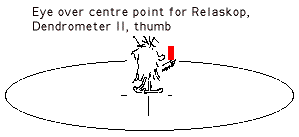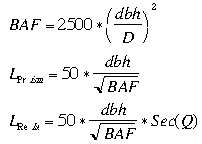
Forest Measurement and Modelling.
 |
Angle count sampling Forest Measurement and Modelling. |
     |
Angle count sampling (ACS) estimates stand basal area from a number of sample points. Although the method is efficient and theoretically unbiased, inappropriate selection of sample points or use of an angle gauge can lead to imprecision or bias. Bias can be introduced by:
Imprecision can be introduced by:
|
|
| Selecting sample points |
The selection of sample points should be statistically valid. Appropriate sample locations can be chosen randomly or by a well-developed systematic sample. Statistically, each point within a stand is an independent sample point. Thus, two points, randomly chosen and falling within a metre of each other are valid even though the same trees may be IN for both points. Counting one tree as IN in more than one sample point can be avoided if new sample points are excluded if they are near an existing point. The minimum distance (L) between points to prevent overlap can be determined from the BAF and an estimate of the largest dbh likely to be encountered. A systematic sampling approach generally avoids this condition by spreading the points across the stand. Excluding points that are close to each other slightly biases the estimate of sampling precision. Avoid introducing bias when locating the selected sample points in the field. For example, if pacing the distance between points, do not veer away from awkward points like blackberry patches, nor towards easy points like open glades. One way to avoid such bias is to ensure an objective approach to measuring distance and bearing is followed. For example, pace most of the distance but when about 20 m from the desired sample point use a tape and exact bearing. |
| Points near the stand boundary |
 An ACS point close to the boundary of a stand will sample an area outside the stand and thus introduce bias. The limiting distance (L), or how close the point can be to the boundary without introducing bias will depend on the maximum dbh tree and the BAF. Where a sample point is closer than L to a boundary or corner, 180 or 90 degree sweeps (respectively) are necessary. Sweep only the half or quarter circle away from the boundary or corner then multiply the estimate of G by 2 or 4 respectively. This method, called Grosenbaugh's method, avoids bias introduced by near-boundary points. An ACS point close to the boundary of a stand will sample an area outside the stand and thus introduce bias. The limiting distance (L), or how close the point can be to the boundary without introducing bias will depend on the maximum dbh tree and the BAF. Where a sample point is closer than L to a boundary or corner, 180 or 90 degree sweeps (respectively) are necessary. Sweep only the half or quarter circle away from the boundary or corner then multiply the estimate of G by 2 or 4 respectively. This method, called Grosenbaugh's method, avoids bias introduced by near-boundary points. |
|
Pushing the point Incorrect placement of angle gauge |
 It is important that the angle gauge instrument be held at the appropriate location determined by the way the angle is generated. Hold a wedge prism precisely over the ACS point centre at all times. This point, and not the observer's eye, is where the reference angle is generated. In contrast, the Relaskop, thumb, stick, etc., generate the angle at the observer's eye. The wedge must be held in a vertical position with the user's eye back at any convenient distance and at right angles to the line of sight. View through the centre of the wedge. It is important that the angle gauge instrument be held at the appropriate location determined by the way the angle is generated. Hold a wedge prism precisely over the ACS point centre at all times. This point, and not the observer's eye, is where the reference angle is generated. In contrast, the Relaskop, thumb, stick, etc., generate the angle at the observer's eye. The wedge must be held in a vertical position with the user's eye back at any convenient distance and at right angles to the line of sight. View through the centre of the wedge.  Pushing the point is where the user rather than the wedge is over the sample point. Unless all near borderline trees are measured, pushing the point will result in an overestimate of G. The overestimate will vary depending on tree dbh, BAF and the distance the wedge prism is from the point centre. Pushing the point is where the user rather than the wedge is over the sample point. Unless all near borderline trees are measured, pushing the point will result in an overestimate of G. The overestimate will vary depending on tree dbh, BAF and the distance the wedge prism is from the point centre. |
| Appropriate BAF |
Angle gauges are available with a range of BAFs. On average, an ACS with a small BAF will select more IN trees than a large BAF. Too many IN trees makes the assessment rather tedious and may result in trees being missed. However, a large BAF leads to lower precision as the G estimate for each sweep jumps substantially for each IN tree. When there are many IN trees in a sweep, miscounting one tree has a relatively minor impact, in contrast to when there are few IN trees. Each tree that is miscounted introduces an error in the estimate of G from that point equal to the BAF in m^2/ha. A satisfactory compromise is a count of 7-12 trees per sample point - not so many trees that a miscount is likely, nor so few trees that the impact of a miscount is relatively high. To select an appropriate BAF, estimate G and divide by 10. This BAF should give about 10 IN trees which is about in the middle of the desired range. For example, stand basal area of fully stocked stands frequently lies in the range 20-50 m^2/ha which suggests BAF values of 2 to 5. Once an appropriate BAF is selected, continue to use the same factor gauge at each point in the assessment. Varying the BAF within an assessment leads to problems in estimating the precision of the estimate of G. |
| Borderline trees |
The accuracy of all angle gauges is sufficient to determine trees that are obviously IN or OUT. That is, trees that are near the boundary for their size cannot reliably be detected by the gauge. Therefore any tree near the boundary should be measured for dbh (m) and actual distance (D in m) from the point centre. The distance D can be compared with the limiting distance (L) and a decision can be made:
 Individuals tend to have a personal bias when counting borderline trees. Van Laar (1970) found a tendency with the angle count instruments to count too many border line trees, while students at the ANU over the past 5 years have been observed to have a range of bias. Therefore, it is very important that trees for which there is any doubt must be measured and compared with the limiting distance for that sized tree and BAF. Failure to check borderline trees will lead to errors in the estimation of G. |

|
[acs.htm] Revision: 6/1999 |